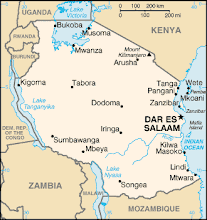When I first started this blog, I set up a Google alert for "Kilimanjaro." So every day I get an email with links to any new posts on blogs and websites that contain the word "Kilimanjaro." It's amazing how many there are every day. I usually spend about an hour a day reading these alerts. Just when I think I have read all that I need to know and/or that I am really wasting my time, I find a site that just blows me away.
I have been trying to wrap my mind around the differences among the various routes - unsuccessfully until now.
Here is it: just as the name says Africa Travel Resource. There is a list on the left of each route. When you place your cursor over the name of a route, it highlights the route on the map. I assume that the dots are the overnight stops. Maybe I am a visual learner but I find this really helpful. This is the first site that I have found that describes a "North" route.
Here's what it says about the different routes:
"Trekkers who are less than absolutely confident about their fitness, or who are pressed for time should start with the Rongai route. Those absolutely confident in their fitness and willing to spend longer on the mountain to increase the chances of summit success should start by taking a look at the Shira route. People not too worried about costs but who simply want the ultimate trek should look at the North route."
This is going to be a really difficult but critical decision.
Saturday, February 27, 2010
Subscribe to:
Post Comments (Atom)



Hi- Nice blog on Kili. I'm doing research myself on routes. Check out http://www.peakplanet.com/routes for info on the North Route (which they call the Northern Circuit)
ReplyDeleteWell, the post is very good and is providing the people with the advice to be alert about the latest updates and information. This is a useful blog for sure for those who are not aware of the things needed to be known before going for climb. There are a lot of companies providing training for climbing Kilimanjaro and these are needed to be joined and visited to have a safe climb.
ReplyDelete